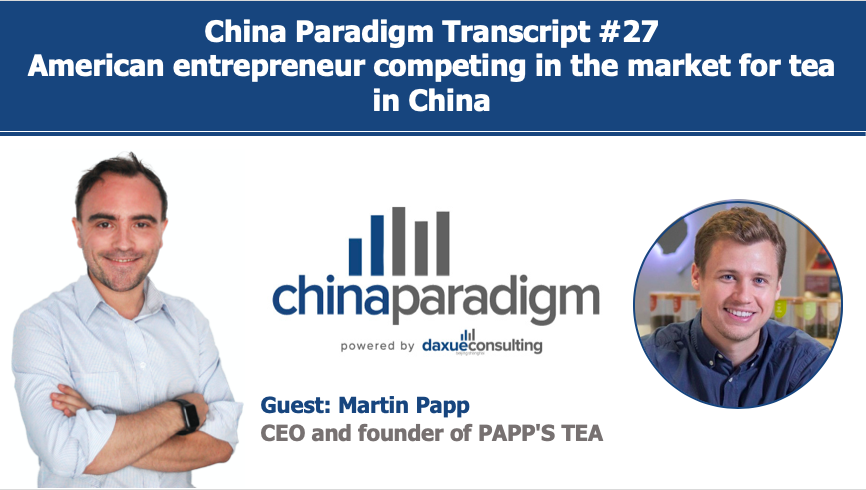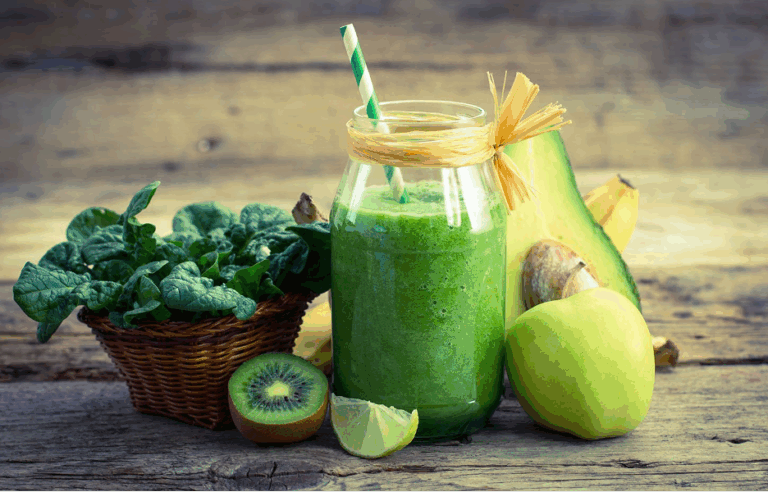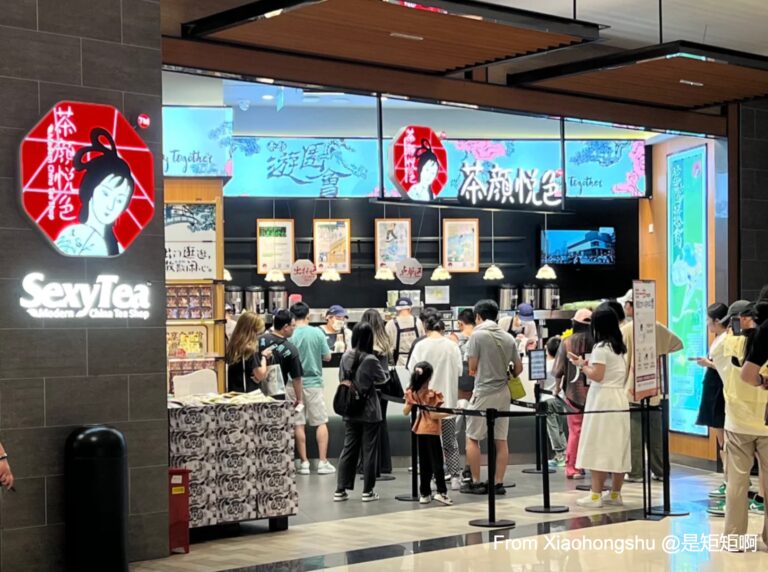This transcript is based on our interview with Martin Papp. Martin has been active in the healthy tea market in China for more than 5 years. He has been developing his beverage company since 2014. PAPP’S TEA is headquartered in Beijing. They sells their healthy tea drinks through private channels but also through Wagas and other restaurants and bars. He is one of the first players in the kombucha market in China.
Listen to the full China Paradigm episode 27 on YouTube, Apple Podcast, Google Podcast, Spotify, and Soundcloud.
Here is the transcript from our interview with an entrepreneur succeeding in the healthy tea market in China and kombucha market in China, Martin Papp
Today we are chatting with Martin Papp, founder and CEO of Papp’s Tea. Papp’s Tea was founded in 2014 in Hong Kong. They sell many different beverages in the healthy tea market in China. Papp’s Tea is also the first commercial supplier in the kombucha market in China. Papp’s Tea faces massive, stiff competition in the healthy tea market in China, and are pioneers in the kombucha market in China. However, much of their revenue in the first few years came from their healthy tea drinks. They managed this by listening to their consumers and targeting specific demographics in the healthy tea market in China.
What is the size of Papp’s Tea?
Martin Papp: My wife and I invested around $300,000 of our money and registered a company in Hong Kong. In 2015 we opened our office and worked on sales and we got our first b2b client in 2016. We now have 85 b2b clients. Our product is high quality, all-natural, full leaf tea and we sell in around 350 locations throughout China. We also do RTD tea drinks and R&D in tea recipe creation. As well as being competitive in the healthy tea market in China, we are also pioneers in the kombucha market in China. We began working with Wagas in 2016 and we work with lots of other Western F&B clients. We are heavily b2b right now but as a start-up, we are flexible and always looking at new possibilities.
Monthly revenue is generally around 700,000 rmb. Papp’s Tea’s annual revenue is over $1 million.
Papp’s Tea has always been envisioned as a b2c brand. B2b was a good way to enter the market but ultimately we want to go more into b2c.
However, Papp’s Tea needs investment to make that happen, we went through one round of angel funding in 2017, worth around $500,000 with bits & bites. At that time Papp’s Tea’s sales were around 200,000 rmb per month. We’ve added some high calibre people to the Papp’s Tea team. One of those is the head of finance from Twinning’s China who obviously would be very familiar with the tea and healthy tea market in China.
Papp’s Tea is still a start-up and is operating under the goal of fast growth.
When did Papp’s Tea break even?
Since summer 2017 we have had positive cash flow. So, 3 years after Papp’s Tea was started.
How did you break into the healthy tea market in China? A market which most people would assume to be a very red ocean full of strong competitors. How did you find a niche in China?
We differentiated ourselves from the competition. The great thing about being here is that if you find a niche in China, it can represent 10 million people across 2 cities. This would be big enough to represent a whole country in Europe. If you focus very directly on a small niche, like certain demographics within the healthy tea market in China or the kombucha market in China, it is easy to start generating enough revenue to justify your business.
Although there are hundreds of thousands of tea producers in China, you can still find a small niche in the healthy tea market in China across 2 or 3 cities which consists of a few million potential customers. We found our niche and our niche is creating high-end Western concept teas. We introduce tea trends such as kombucha, turmeric or chai tea or yerba maté that have taken off in the west and a lot of Chinese tea producers are slow to jump on these trends. Most Chinese companies involved in the healthy tea market in China have chosen to target a high-end, older demographic.
And then there are the stores like Hey Tea, Coco, and other bubble tea establishments which target young consumers. We targeted where we felt there was a void, which was people between those age groups who are generally 25 – 35. They are generally white-collar, have exposure to Western culture, and want a high-quality tea experience without necessarily having to go into a tea house. And we have had very positive feedback from businesses who are looking for our kinds of products. So it proves that it is not too difficult to find a niche in China.
Can you describe the products you sell in China?
Papp’s Tea sells loose leaf tea which is bought in bulk. Also we do tea bags and bottled tea like kombucha.
Unlike most start-ups, Papp’s Tea has a very high number of SKUs. We have around 150 SKUs. It used to be more, but we learned to scale back as much as possible.
So you don’t really follow the Pareto Principle in terms of just focusing on a small handful of your best selling products and getting rid of everything else?
Well the principle applies to the healthy tea market in China too but if a customer comes to us with an interesting suggestion for a healthy tea drink, we will actually go and try to make it for them. It’s a lot of work but the advantage of being a start-up is that you don’t have to follow the 80/20 principle religiously. We can be more flexible than a big producer. We can win more customers over to our brand because we listen to them. It’s worth it for us to have them as a customer whereas it’s not worth it for a big tea brand to make customized products.
What’s regulation like in the tea or kombucha market in China? Is it difficult to start a drinks business in China?
Compared to the US, running a beverage business in China is very hard. There’s a lot of red tape, you need to have scale, and you need to have a lot of capital. Kombucha was very hard to get through all the regulation processes. If I had just started a kombucha brand I would be in trouble now. But the other products we sell in the healthy tea market in China have kept our heads above water as we tackle the regulation nightmares of entering the kombucha market in China.
One of the ways you can get through the tough tea producing regulations in China is to find partners. Don’t build a factory yourself. Papp’s Tea has outsourced the production of most teas to another factory in China. However, that won’t work for kombucha because there are no other producers. You need to find a manufacturing partner who can customize their production facilities to your specifications without paying huge fees or having to meet huge MOQs. So, the process of finding this partner was long and hard. We literally visited over 30 factories and talked with over 100 on the phone.
In the end, we were unable to find a factory that could both produce and bottle the kombucha so we outsource these 2 jobs to 2 different factories.
What are the main issues Papp’s Tea faces with potential tea production partners in China?
Consistency, making sure every batch of the product is the exact same. But really, in every step of production, you’re going to run into problems. It’s going to take several iterations before you find the product you’re satisfied with. We are on our third version of kombucha. In China, I have found the best way to do business is to follow the Lean Start-Up method.
In China, you have to be fast in terms of updating your products. The market will not allow you to change only 10% of your products every year, you need to be changing as much as 50% of what you offer to keep ahead of the competition in the healthy tea market in China. This is an advantage for Papp’s Tea because we are smaller and more flexible.
How did Papp’s Tea find investors in the healthy tea market in China?
I read a news article by bits & bites where they said they were looking for products in the healthy tea market in China to invest in. Also, I told a friend and he said he would be interested in investing. So I met with 4 people and I got investment from 2 of them. However, in 2018 I tried to raise another round and met with over 20 VCs and failed to get investment from any of them. I plan on doing a new round at the end of 2019.
Surprisingly, in 2018 I thought I had a better pitch deck, had better sales but none of them was interested. At that point, I stopped looking and decided to focus on sales and adding key members to our team to better prepare Papp’s Tea for the next round.
What does Papp’s Tea need the funding for?
We want to do more b2c. We want to do a lot of online and offline sales channels, and go to trade shows because these are important when you want to compete in the healthy tea market in China. Also usually, I get paid 60 days after an order so we need capital to hold us over until then because it’s so hard to get loans as a start-up from banks in China.
How often did you meet with Papp’s Tea’s investors at the start?
Initially it was a call once a week for the first 6 months. Then about once a month, and now it’s on an ad hoc basis. However, they were very helpful, it was always them asking how they could help me.
Can you define a little bit the kombucha market in China?
Interestingly, kombucha started its life in China before dying out in popularity and resurfacing in the west where it is now a $billion industry in the US. We are taking this healthy drink with ancient Chinese origins, putting a western spin on it and re-launching it in China. We were the first commercial supplier in the kombucha market in China. But actually, the difficulty is that in China, consumers are already well educated about the benefits of fermented beverages. So, there are many fermented drink products that you need to compete with and differentiate yourself from. Currently, we target ex-pats looking for kombucha, and 25 to 35-year-old Chinese, white-collar workers with exposure to Western culture.
However, in the future, Papp’s Tea will look to have a broader appeal. Targeting people looking for healthy tea drinks with low calories and low sugar and that have the purchasing power to try craft-products. Papp’s Tea kombucha retails at 28 rmb per 280 ml bottle. We are also looking at the athletic community. Also, kombucha sells really well in some craft bars as a non-alcoholic drink substitute. So that has been a surprisingly lucrative sales channel in the kombucha market in China.
Also, we will be trying to go on all major e-commerce platforms in China. We will work with KOLs for that.
There is a market problem in China and it is not that young people do not like tea. In fact, China’s youth are overwhelmingly tea rather than coffee drinkers. The problem with the healthy tea market in China is that the insular and sacred nature of a tea house experience is uncool to young Chinese consumers. There was no Starbucks style tea-house, which meant that young consumers looking for something trendy just started going to Starbucks, but this gap is being filled very quickly.
Listen to the full China Paradigm episode 27 on YouTube, Apple Podcast, Google Podcast, Spotify, and Soundcloud.





